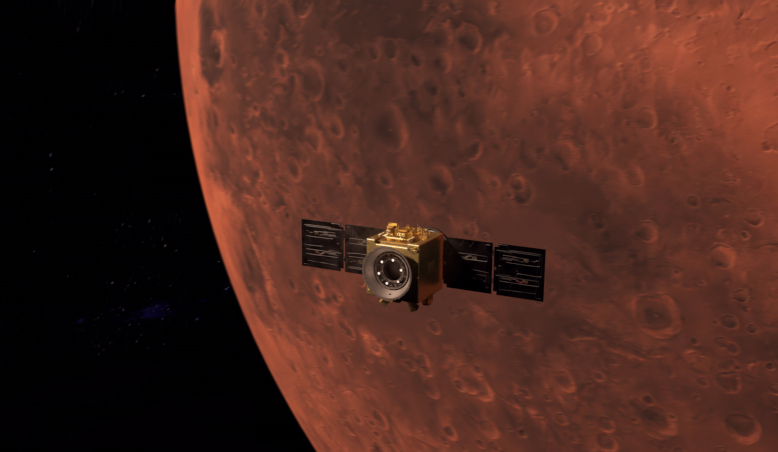The Emirates Mars Mission’s Hope Probe has officially reached Mars, entering its Mars capture orbit at 19:57 UAE time (15:57 UTC). The first interplanetary mission undertaken by an Arab nation, the confirmation of Mars Orbit Insertion (MOI) makes the Emirates the fifth space-farer to reach the Red Planet after the US, Soviet Union, Europe and India.
Hope reached Mars after a seven-month, over 493.5 million-kilometre journey following its launch from the Tanegashima, Japan, on 19 July 2020. The probe fired its six Delta-V thrusters for 27 minutes to slow the spacecraft down from its cruising speed of 121,000 kilometres per hour (km/h) to some 18,000 km/h to achieve Mars Orbital Insertion (MOI).
It will maintain this capture orbit, calibrating and testing its science instruments, before moving to its science orbit. Hope will provide the first planet-wide picture of Mars’ weather system and climate throughout the Martian year.
Omran Sharaf, EMM Project Director at the Mohammed bin Rashid Space Centre, said:“MOI was the most critical and dangerous part of our journey to Mars, exposing the Hope probe to stresses and pressures it has never before faced. While we have spent six years designing, testing and retesting the system, there is no way to fully simulate the impacts of the deceleration and navigation required to achieve MOI autonomously. With this enormous milestone achieved, we are now preparing to transition to our science orbit and commence science data gathering.”
With an 11-minute one-way radio delay to Earth, the probe had to rely on autonomous self-correcting systems to achieve MOI, managing any exceptional circumstance and mitigating any system failures or performance issues during the operation without human intervention.
Her Excellency Sarah bint Yousef Al Amiri, UAE Minister of State for Advanced Technology and Chair of the UAE Space Agency, said: “Hope reaches Mars at a profound double anniversary: 2021 marks both the 50th anniversary of the Emirates and 50 years since the first man-made object landed on the Red Planet. As a young nation, it is a particular point of pride that we are now in a position to make a tangible contribution to humanity’s understanding of Mars. This also marks an important point for the Emirates to continue the drive to diversity its economy utilizing science and technology.”
Hope’s next phase and scientific mission
Hessa Al Matroushi, Science Lead for the mission at the UAE’s Mohammed Bin Rashid Space Centre, said: “The science of the mission is enabled by a unique highly elliptical orbit that Hope will adopt when it starts its two-year science mission. The orbit offers an unprecedented local and seasonal time coverage of the Martian atmosphere. Combined with the unique instrumental synergy, Hope will explore Mars different atmospheric layers revealing new and global perspective of its atmospheric behavior and connections."
Over the coming two months, Hope will perform instrumentation and system tests and will also transition from its capture orbit of between 1,000 and 49,380 km from Mars to its science orbit. The science orbit is unique and innovative, providing unparalleled coverage of the planetary atmosphere.
From the dynamic vantage point Hope’s elliptical (20,000 – 43,000 kilometres) science orbit provides, the spacecraft can explore changes in the Martian climate between the upper and lower atmosphere, across the entire surface of the planet, at all times of day, and through all the seasons of the year. It will orbit every 55 hours and capture a full Martian image every nine days.
The first set of scientific data will be released in September and made openly available to scientists globally, contributing to humanity’s shared understanding of our second-closest planet. The first scientific results and findings by the EMM science team will be released in early December. The mission was designed to disrupt and accelerate innovation and scientific research in the Emirates, as well as to inspire younger generations in the Middle East to study and take up careers in science.
During the five days prior to Hope’s MOI, the Emirates lit up red in celebration of the feat, with major public monuments, heritage buildings and landmarks illuminated in a nation-wide light show. UAE Prime Minister Sheikh Mohammed bin Rashid Al Maktoum, who originally mandated the mission in 2014, referred to Hope as ‘a symbol for all Arabs.’











